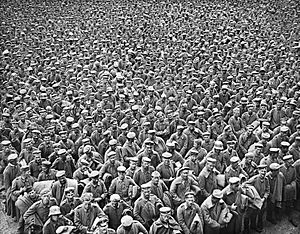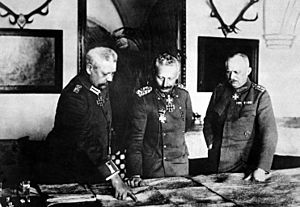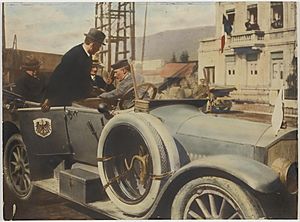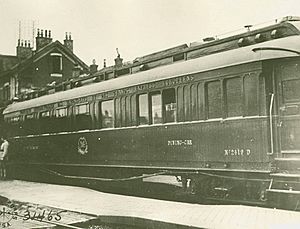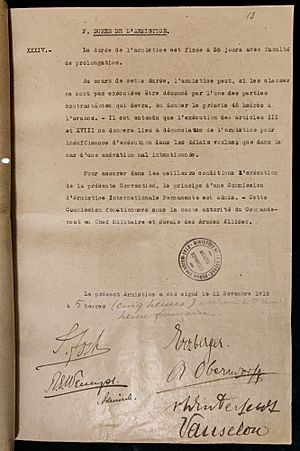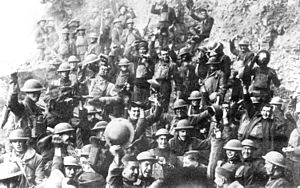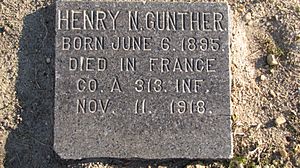Armistice of 11 November 1918 facts for kids
The Armistice of 11 November 1918 was an important agreement that stopped the fighting on land, sea, and in the air during World War I. It was signed near Compiègne, France, between the Allies and Germany. Before this, other countries like Bulgaria, the Ottoman Empire, and Austria-Hungary had already signed their own armistices.
Germany asked American President Woodrow Wilson to help negotiate peace. They based their request on his ideas, especially his "Fourteen Points". These points later helped shape the peace talks that happened the next year.
This agreement is also known as the Armistice of Compiègne. It was officially signed at 5:45 a.m. by the Allied commander, French Marshal Ferdinand Foch. The fighting officially stopped at 11:00 a.m. Central European Time on 11 November 1918. This marked a big victory for the Allies and a defeat for Germany, even though it wasn't a formal surrender.
The terms of the Armistice were mostly written by Marshal Foch. They included stopping all fighting on the Western Front. German forces had to leave the areas west of the Rhine river. Allied troops would then occupy the Rhineland and other areas. Germany also had to hand over many aircraft, warships, and military equipment. Allied prisoners of war were to be released. Germany would also have to pay for the damage caused by the war later on. The naval blockade of Germany continued. The Armistice was extended three times while a peace treaty was being worked out. The final peace treaty, the Treaty of Versailles, was signed on 28 June 1919 and started on 10 January 1920.
Sadly, fighting continued right up until 11:00 a.m. on 11 November 1918. On that last day of the war, 2,738 soldiers died.
Contents
Why the Armistice Happened
Germany's Difficult Situation
The situation for Germany and its allies (the Central Powers) had been getting much worse since August 1918. The Allies had pushed back the German army in what was called the Hundred Days Offensive. This forced Germany to retreat to their strong defense line, the Hindenburg Line. On 28 September, American and French forces launched a huge attack called the Meuse–Argonne offensive. At the same time, British forces were ready to attack the St Quentin Canal. This created a big threat to the German army.
Meanwhile, the Ottoman Empire was very tired from the war. The Austro-Hungarian Empire was falling apart. On the Macedonian front, the Bulgarian Army had given up, signing an armistice on 29 September. In Germany, there were severe food shortages because the Allies had blocked their ports. This led to a lot of unhappiness and disorder among the people. Even though the soldiers on the front line still had some morale, many were dying or getting sick from the Spanish flu. There weren't enough new soldiers, and those who were left were tired of fighting.
Messages in October 1918
On 29 September 1918, Germany's top military leaders told Emperor Wilhelm II that the war was hopeless. General Erich Ludendorff said he couldn't guarantee the front would hold for even two more hours. He demanded that Germany ask the Allies for an immediate ceasefire. He also suggested accepting President Wilson's "Fourteen Points" to get better peace terms. He hoped this would save the reputation of the German army and put the blame for the surrender on the new democratic government.
On 3 October 1918, Prince Maximilian of Baden became Germany's new leader (Chancellor). He was chosen to negotiate an armistice. On 5 October, the German government sent a message to President Wilson to discuss peace based on his "Fourteen Points." Wilson made it clear that for peace talks to happen, Germany had to withdraw from all occupied lands, stop submarine attacks, and the Kaiser had to give up his throne. He wrote on 23 October that if the US had to deal with Germany's military leaders and emperor, it would demand surrender, not peace talks.
Later in October, Ludendorff suddenly changed his mind. He said the Allies' conditions were unacceptable and wanted to restart the war. But by then, the German army had low morale, and many soldiers were deserting. The government decided to stick to its plan, and Ludendorff was replaced. On 5 November, the Allies agreed to talk about a truce, also demanding that Germany pay for damages.
The final message from President Wilson arrived in Berlin on 6 November 1918. That same day, the German team, led by Matthias Erzberger, left for France.
A big problem that delayed the Armistice was that France, Britain, and Italy didn't fully agree with President Wilson's "Fourteen Points." They saw them as a way to weaken Germany, not as a plan for a fair peace for everyone. They also had their own plans for after the war that didn't fit with all of Wilson's ideas, like national self-determination.
German Revolution
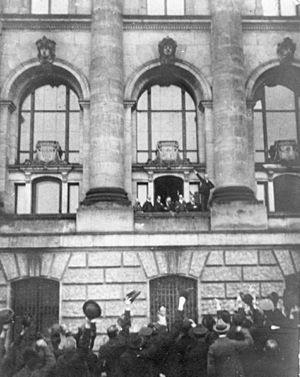
A sailors' revolt began on 29 October 1918 in the naval port of Wilhelmshaven. This revolt quickly spread across Germany. It led to the announcement of a republic on 9 November and the Kaiser Wilhelm II giving up his throne. In some places, soldiers even challenged their officers and formed their own councils.
Also on 9 November, Max von Baden handed over his role as Chancellor to Friedrich Ebert, a Social Democrat. Ebert's party and Erzberger's Catholic Centre Party had often disagreed with the Imperial government. They had been asking for a negotiated peace since 1917. Their important role in the peace talks later made the new Weimar Republic seem weak to some people on the right-wing and in the military.
How the Negotiations Happened
The Armistice was agreed upon very quickly because Germany was desperate. The German team, led by Matthias Erzberger, traveled across the war-torn areas of Northern France. They arrived on the morning of 8 November 1918. They were then taken to a secret location: Ferdinand Foch's private train, which was parked in a railway siding in the Forest of Compiègne.
Marshal Foch only appeared twice during the three days of talks. On the first day, he asked the German team what they wanted. On the last day, he was there for the signing. The Germans were given a list of the Allies' demands and had 72 hours to agree. The German team discussed the terms with other French and Allied officers, not directly with Foch. The Armistice meant Germany had to give up almost all its military power. The Allies made very few promises in return. The naval blockade of Germany was not fully lifted until a complete peace treaty was agreed upon.
There wasn't much room for negotiation. The Germans managed to correct a few impossible demands, like asking for more submarines than they had. They also got a bit more time for their troops to withdraw. But they couldn't refuse to sign. On Sunday, 10 November 1918, the Germans saw newspapers from Paris that announced the Kaiser had given up his throne. That same day, Ebert told Erzberger to sign the Armistice. The German military leader, Paul von Hindenburg, had also sent a message saying the armistice should be signed even if the conditions couldn't be improved.
The Armistice was agreed upon at 5:00 a.m. on 11 November 1918. It was set to begin at 11:00 a.m. Central European Time. This is why it's often called "the eleventh hour of the eleventh day of the eleventh month." The actual signing happened between 5:12 a.m. and 5:20 a.m.
Allied Occupation of the Rhineland
After the Armistice, Allied forces from America, Belgium, Britain, and France occupied the Rhineland area of Germany.
Extending the Armistice
The Armistice was extended three times before the final peace treaty was approved. During this time, some details were also added.
- First Armistice (11 November 1918 – 13 December 1918)
- First extension (13 December 1918 – 16 January 1919)
- Second extension (16 January 1919 – 16 February 1919)
- Third extension (16 February 1919 – 10 January 1920)
The final peace was confirmed at 4:15 p.m. on 10 January 1920.
Key People Involved
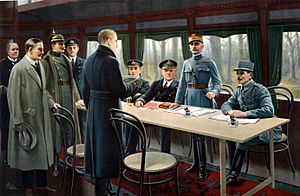
For the Allies, all the people involved were military leaders. The two main signers were:
- Marshal of France Ferdinand Foch, who was the supreme commander of the Allied forces.
- First Sea Lord Admiral Rosslyn Wemyss, the British representative.
Other important members of their team included:
- General Maxime Weygand, Foch's chief of staff.
- Rear-Admiral George Hope, a British naval officer.
- Captain Jack Marriott, another British naval officer.
For Germany, the four signers were:
- Matthias Erzberger, a civilian politician.
- Count Alfred von Oberndorff, from the Foreign Ministry.
- Major General Detlof von Winterfeldt, from the army.
- Captain Ernst Vanselow, from the navy.
Two translators also came with the German team.
Main Terms of the Armistice
The Armistice agreement had 34 rules. Here are some of the most important ones:
- Stopping the Fighting: All fighting on the Western Front, on land and in the air, had to stop within six hours of the signing.
- Leaving Occupied Lands: German troops had to leave France, Belgium, Luxembourg, and Alsace-Lorraine within 15 days.
- Returning People: All people from those four areas who were held by Germany had to be sent home right away.
- Giving Up Equipment: Germany had to hand over a lot of military equipment, including 5,000 artillery guns, 25,000 machine guns, 1,700 aircraft, 5,000 railway engines, and 150,000 railway carriages.
- Leaving the Rhine Area: German troops had to leave the land on the west side of the Rhine river. They also had to leave areas around the cities of Mainz, Koblenz, and Cologne on the east side of the Rhine within 31 days.
- Allied Occupation: Allied troops would occupy the areas Germany left, and Germany would have to pay for them.
- No Destruction: Germany was not allowed to remove or destroy anything in the areas they left, including roads, railways, bridges, and military buildings.
- Identifying Mines: All minefields on land and sea had to be marked.
- Eastern and African Fronts:
* German troops had to leave Romania, the Ottoman Empire, the Austro-Hungarian Empire, and the Russian Empire. They had to return to German territory as it was on 1 August 1914. * Germany had to cancel its peace treaties with Russia (Treaty of Brest-Litovsk) and Romania (Treaty of Bucharest). * German forces in Africa also had to leave.
- At Sea:
* All fighting at sea had to stop immediately. * All German submarines had to surrender within 14 days. * Certain German surface warships had to be held within 7 days, and the rest had to be disarmed. * Allied ships could freely enter German waters. * The naval blockade of Germany would continue. * Germany had to leave all Black Sea ports and hand over any captured Russian ships.
- General Rules:
* All Allied prisoners of war and civilians held by Germany had to be released immediately. Germany would not get its prisoners back at this time. * Germany had to return valuable items taken from Belgium, Romania, and Russia.
What Happened Next
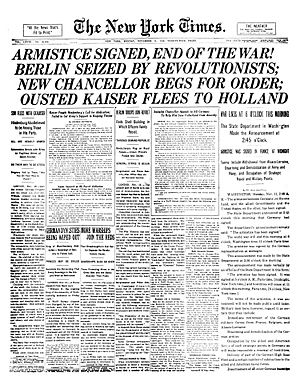
The British public heard about the Armistice at 10:20 a.m. when Prime Minister David Lloyd George announced: "The armistice was signed at five o'clock this morning, and hostilities are to cease on all fronts at 11 a.m. to-day." In the United States, an official announcement was made at 2:30 p.m.
News of the signing reached Paris around 9:00 a.m. Marshal Foch went to the Ministry of War and met with the Prime Minister of France, Georges Clemenceau. At 10:50 a.m., Foch gave a general order: "Hostilities will cease on the whole front as from November 11 at 11 o'clock. The Allied troops will not, until further order, go beyond the line reached on that date and at that hour." Five minutes later, Clemenceau, Foch, and a British admiral went to the Élysée Palace. When the first shot was fired from the Eiffel Tower, flags were raised, and bells rang across Paris. Crowds gathered, and Clemenceau appeared on a balcony, shouting "Vive la France!" At 11:00 a.m., a peace-gunshot from Fort Mont-Valérien told everyone in Paris that the Armistice had begun.
Even though soldiers at the front knew about the ceasefire, fighting continued in many areas right up until 11:00 a.m. At 11:00 a.m., some soldiers from both sides briefly met in peace. But generally, reactions were quiet. A British soldier said: "...the Germans came from their trenches, bowed to us and then went away. That was it." There wasn't much cheering or excitement. After 52 long months of war, the main feeling was silence and emptiness.
The final peace between the Allies and Germany was settled in 1919 with the Treaty of Versailles.
Last Casualties
Many artillery units kept firing at German targets to avoid having to move their extra ammunition. The Allies also wanted to be in the best possible position if fighting started again. Because of this, there were 10,944 casualties, and 2,738 men died on the last day of the war.
For example, a US Navy long-range gun fired its last shot at 10:57:30 a.m., aiming for it to land just before the Armistice began.
Augustin Trébuchon was the last Frenchman to die. He was shot at 10:45 a.m. while going to tell other soldiers that hot soup would be served after the ceasefire.
Marcel Toussaint Terfve was the last Belgian soldier to die. He was badly wounded by German machine gun fire and died at 10:45 a.m.
The last British soldier to die, George Edwin Ellison, was killed around 9:30 a.m. while scouting in Belgium.
The last Canadian soldier, Private George Lawrence Price, was shot by a sniper just two minutes before the Armistice, at 10:58 a.m.
Henry Gunther, an American, is usually seen as the very last soldier killed in action in World War I. He was killed 60 seconds before the Armistice started. He was charging at German troops who knew the ceasefire was coming. He was reportedly trying to make up for a recent reduction in his rank.
News of the Armistice only reached Germany's forces in Africa about two weeks later. The German and British commanders there then had to arrange their own armistice ceremony.
After the war, there was a feeling of shame that so many soldiers died on the last day, especially after the treaty was signed but not yet in effect. In the United States, Congress investigated why this happened. In France, many graves of soldiers who died on 11 November were changed to 10 November.
Legacy of the Armistice
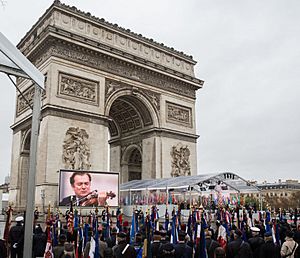
The celebration of the Armistice became a very important way to remember the war. Many countries built monuments to honor the soldiers who died. 11 November is now celebrated every year in many countries. It's known by different names like Armistice Day, Remembrance Day, and Veterans Day. In Poland, it's called Independence Day.
During World War II, after Germany won the Battle of France, Adolf Hitler made sure that the new peace talks with France happened in the same railway car where the 1918 Armistice was signed. This was seen as revenge for Germany's earlier defeat. The area where the signing happened was mostly destroyed.
The end of World War II in China happened on 9 September 1945 at 9:00 a.m. This date was chosen to remind people of the 1918 Armistice (on the eleventh hour of the eleventh day of the eleventh month). Also, the number "nine" sounds like the word for "long lasting" in Chinese, suggesting that the peace would last forever.
Stab-in-the-back Myth
After the war, a false idea spread in Germany that the German Army was "stabbed in the back" by the new Social Democratic government that formed in November 1918. This idea came from German newspaper articles that wrongly described a British general's book.
In a meeting on 18 November 1919, a year after the war ended, German military leader Hindenburg said, "As an English general has very truly said, the German Army was 'stabbed in the back'."
See also
 In Spanish: Armisticio del 11 de noviembre de 1918 para niños
In Spanish: Armisticio del 11 de noviembre de 1918 para niños
- Armistice Day
- Compiègne Wagon
- Remembrance Day
- Veterans Day
Images for kids
-
Photograph taken after reaching agreement for the armistice that ended World War I. This is Ferdinand Foch's own railway carriage in the Forest of Compiègne. Foch's chief of staff Maxime Weygand is second from left. Third from the left is the senior British representative, Sir Rosslyn Wemyss. Foch is second from the right. On the right is Admiral Sir George Hope.


